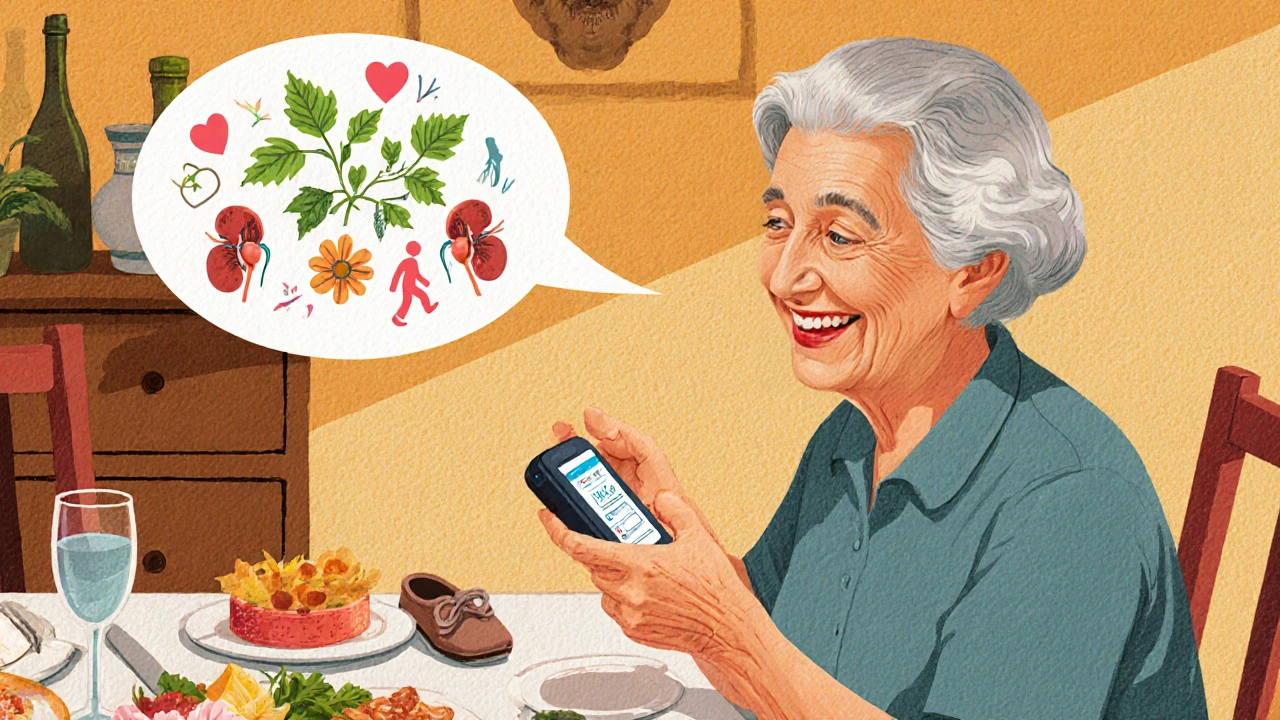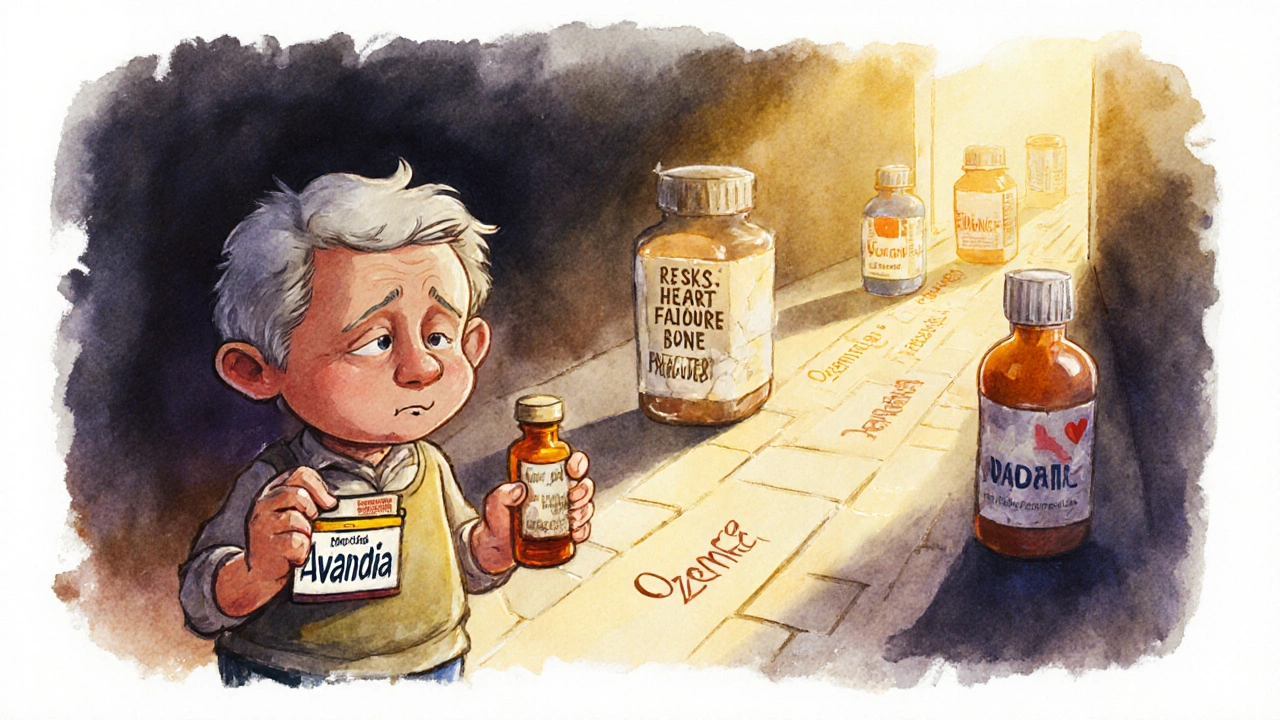Diabetes Medication Comparison Tool
Filter by Key Benefits
Medication Comparison Table
| Medication | Class | HbA1c Reduction | Weight Effect | Heart Protection | Kidney Protection |
|---|---|---|---|---|---|
| Avandia (Rosiglitazone) | TZD | 1.0%–1.5% | Weight Gain (2–4 kg) | No | No |
| Metformin | Biguanide | 1.0%–2.0% | Weight Neutral or Loss | Yes (modest) | Yes (some benefit) |
| Empagliflozin (Jardiance) | SGLT2 Inhibitor | 0.5%–1.0% | Weight Loss (2–5 kg) | Yes (reduces heart failure) | Yes (slows kidney decline) |
| Semaglutide (Ozempic) | GLP-1 RA | 1.0%–1.8% | Weight Loss (5–15 kg) | Yes (reduces heart attack/stroke) | Yes (moderate benefit) |
| Sitagliptin (Januvia) | DPP-4 Inhibitor | 0.5%–0.8% | Weight Neutral | No clear benefit | No |
| Insulin | Insulin | 1.0%–2.0% | Variable | Depends on type | Some benefit |
How This Helps You
This comparison shows why modern diabetes treatments are safer and more effective than Avandia. Look for options with heart and kidney protection, weight loss benefits, and fewer side effects.
Key Takeaway: None of the top alternatives carry Avandia's risks. Most offer benefits Avandia never did: weight loss, heart protection, and kidney support.
Avandia was once a go-to pill for type 2 diabetes, promising better blood sugar control by making your body more sensitive to insulin. But over the past 15 years, its reputation has taken a sharp turn. Today, doctors rarely prescribe it - and for good reason. If you’re still taking Avandia or were recently switched off it, you’re probably wondering: what’s actually better? And why?
What Avandia (Rosiglitazone) Actually Does
Avandia’s active ingredient, rosiglitazone, belongs to a class of drugs called thiazolidinediones (TZDs). These work by activating PPAR-gamma receptors in fat, muscle, and liver cells. This helps those cells respond better to insulin, lowering blood sugar without forcing your pancreas to pump out more of it.
That sounds good - until you look at the side effects. Studies from the early 2000s showed Avandia reduced HbA1c by about 1% to 1.5% on average. That’s comparable to metformin or sulfonylureas. But here’s the catch: patients taking Avandia had a 43% higher risk of heart failure and a 33% increased chance of bone fractures, especially in women over 50. The FDA added a black box warning in 2007. By 2010, it was banned in Europe and severely restricted in the U.S.
Today, Avandia is only available in the U.S. through a special restricted program. You need to be enrolled, sign paperwork, and your doctor must certify you’ve tried everything else. Most patients never get it. And if you’re on it now, your doctor likely wants you off.
Why Avandia Is No Longer First-Line
Medicine doesn’t change overnight. But when safety data piles up, guidelines shift fast. The RECORD trial in 2009, which followed over 4,400 patients for five years, confirmed what earlier studies hinted at: Avandia increases heart-related hospitalizations. That’s not a small risk. It’s life-altering.
Meanwhile, newer drugs came along that didn’t just lower blood sugar - they protected the heart. GLP-1 receptor agonists like semaglutide (Ozempic) and SGLT2 inhibitors like empagliflozin (Jardiance) showed not only better glucose control but also reduced heart attacks, strokes, and kidney damage. These weren’t just improvements. They were breakthroughs.
Avandia had no such benefits. It didn’t help the heart. It didn’t help the kidneys. It didn’t help with weight. In fact, patients gained 2-4 kg on average. That’s the opposite of what most people with type 2 diabetes need.
Top Alternatives to Avandia Today
If you’re looking to replace Avandia, you have options - and most are safer, more effective, and easier to use.
- Metformin: Still the #1 starter drug for type 2 diabetes. It’s cheap, well-studied, and doesn’t cause weight gain. It reduces HbA1c by 1%-2% and lowers heart disease risk. Side effects? Mostly stomach upset - which usually fades after a few weeks.
- SGLT2 Inhibitors (empagliflozin, dapagliflozin, canagliflozin): These make your kidneys flush out sugar through urine. They lower HbA1c by 0.5%-1%, help with weight loss (2-5 kg), and cut heart failure hospitalizations by up to 30%. They also slow kidney disease progression - a huge plus if you have early signs of kidney damage.
- GLP-1 Receptor Agonists (semaglutide, liraglutide, dulaglutide): These mimic a natural hormone that slows digestion, reduces appetite, and boosts insulin. They lower HbA1c by 1%-1.8%, promote weight loss (up to 10-15 kg in some cases), and reduce cardiovascular events. Some are now available as weekly injections; others are pills (like Rybelsus).
- DPP-4 Inhibitors (sitagliptin, linagliptin): These are oral pills that gently raise insulin levels after meals. They lower HbA1c by 0.5%-0.8%, don’t cause weight gain or low blood sugar, and are easy to tolerate. Less powerful than metformin or GLP-1s, but useful as add-ons.
- Insulin: Sometimes needed if other drugs fail. Modern insulins like degludec or glargine are long-acting and stable. They work reliably but require careful dosing and monitoring. Not ideal for everyone - but lifesaving when needed.

How These Alternatives Compare Side by Side
| Medication | Class | HbA1c Reduction | Weight Effect | Heart Protection | Kidney Protection | Common Side Effects |
|---|---|---|---|---|---|---|
| Avandia (Rosiglitazone) | TZD | 1.0%-1.5% | Weight Gain (2-4 kg) | No | No | Fluid retention, bone fractures, heart failure |
| Metformin | Biguanide | 1.0%-2.0% | Weight Neutral or Loss | Yes (modest) | Yes (some benefit) | Diarrhea, nausea (usually temporary) |
| Empagliflozin (Jardiance) | SGLT2 Inhibitor | 0.5%-1.0% | Weight Loss (2-5 kg) | Yes (reduces heart failure) | Yes (slows kidney decline) | Urinary tract infections, genital yeast, dehydration |
| Semaglutide (Ozempic) | GLP-1 RA | 1.0%-1.8% | Weight Loss (5-15 kg) | Yes (reduces heart attack/stroke) | Yes (moderate benefit) | Nausea, vomiting, constipation |
| Sitagliptin (Januvia) | DPP-4 Inhibitor | 0.5%-0.8% | Weight Neutral | No clear benefit | No | Headache, mild stomach upset |
As you can see, none of the top alternatives carry Avandia’s risks. And most offer benefits Avandia never did: weight loss, heart protection, kidney support. Even metformin - the oldest drug on the list - is safer and more widely used today than Avandia ever was.
When Might a Doctor Still Consider Avandia?
It’s rare - but not impossible. A doctor might consider Avandia only if:
- You’ve tried every other class of diabetes drug and still can’t reach your HbA1c target.
- You have severe insulin resistance and don’t respond to metformin, GLP-1s, or SGLT2 inhibitors.
- You have no history of heart disease, heart failure, or bone fractures.
- You’re willing to accept the risks and commit to regular monitoring (monthly weight checks, blood pressure, and heart function tests).
Even then, most doctors will try combining two newer drugs first - like metformin + SGLT2 inhibitor - before even thinking about Avandia. It’s not a first, second, or even third choice anymore. It’s a last resort.

What to Do If You’re Still Taking Avandia
If you’re on Avandia right now, don’t stop cold turkey. That can cause dangerous spikes in blood sugar. Instead:
- Call your doctor. Ask if Avandia is still the best option for you - especially if you’re over 60, have high blood pressure, or have ever had heart issues.
- Request a full review of your diabetes management. Ask about switching to metformin, an SGLT2 inhibitor, or a GLP-1 agonist.
- Get your HbA1c, kidney function, and heart health checked. These numbers will help your doctor decide what’s safest.
- If you’re prescribed a new drug, give it 8-12 weeks to work. Don’t expect instant results.
Many people who switch off Avandia report feeling better - less swelling in their legs, more energy, and fewer trips to the bathroom at night. Those are signs your body is responding to a safer, more modern treatment.
What About Generic Rosiglitazone?
Yes, generic rosiglitazone still exists. But it’s not cheaper than other generics - and it carries the same risks. Insurance companies rarely cover it unless you’ve exhausted every other option. And even then, many pharmacies won’t stock it.
If you’re paying out-of-pocket for Avandia, you’re likely spending more than you would on metformin or sitagliptin. And you’re taking on far more risk. There’s no financial or medical upside.
Final Thoughts: It’s Not About the Pill - It’s About Your Health
Avandia was a product of its time. Back then, we thought lowering blood sugar was the only goal. Now we know: it’s not just about the number on the test strip. It’s about keeping your heart strong, your kidneys working, and your body healthy for decades.
The alternatives today aren’t just better. They’re smarter. They don’t just treat diabetes - they protect you from its worst complications. If you’re still on Avandia, you’re using a tool from 20 years ago when better ones are right in front of you.
Don’t wait for a problem to happen. Talk to your doctor. Ask what’s next. Your future self will thank you.
Is Avandia still available in 2025?
Yes, but only in the U.S. under a strict restricted access program. It’s banned in the EU and Australia. Even in the U.S., doctors must prove you’ve tried all safer options before prescribing it. Most pharmacies don’t stock it.
Why was Avandia pulled from most markets?
Large clinical trials showed Avandia significantly increased the risk of heart attacks, heart failure, and bone fractures. The FDA and EMA concluded the risks outweighed the benefits, especially when safer alternatives existed. It was never pulled for being ineffective - it was pulled for being dangerous.
What’s the safest drug for type 2 diabetes today?
Metformin remains the safest first choice for most people. For those needing more, SGLT2 inhibitors (like Jardiance) and GLP-1 receptor agonists (like Ozempic) are now preferred because they lower blood sugar while protecting the heart and kidneys - with fewer side effects than Avandia.
Can I switch from Avandia to Ozempic on my own?
No. Never stop or switch diabetes medications without medical supervision. Abruptly stopping Avandia can cause high blood sugar. Starting Ozempic requires careful dosing and monitoring for side effects like nausea. Your doctor will guide a safe transition, usually over 4-8 weeks.
Does Avandia cause weight gain?
Yes. Patients on Avandia typically gain 2 to 4 kilograms (4-9 pounds) within the first year. This is due to fluid retention and increased fat storage. Weight gain makes insulin resistance worse - which defeats the purpose of treating diabetes.
Are there natural alternatives to Avandia?
No natural supplement replaces Avandia’s mechanism. Berberine has shown some blood sugar-lowering effects in studies, but it’s not as reliable or regulated as prescription drugs. Lifestyle changes - diet, exercise, weight loss - are the most powerful "alternatives" and should always be combined with medication, not used instead of it.
When it comes to managing type 2 diabetes, the goal isn’t just to take a pill. It’s to live longer, healthier, and with fewer complications. Avandia was a step in the wrong direction. The path forward is clearer than ever.


12 Comments
Shilah Lala
So Avandia was the diabetes version of a toxic ex? 😅 Still got the receipt, still got the baggage, but now everyone’s like ‘we’re done’ and moving on to Ozempic with its little weekly injection and dramatic weight loss TikTok fame. I’m just here for the drama and the side effects chart. 🍿
Christy Tomerlin
Europe banned it? Of course they did. They ban everything that works too well. We still have it here because Americans know how to handle risk. If you can’t handle a little fluid retention, maybe you shouldn’t be eating carbs in the first place. 🇺🇸
Susan Karabin
Metformin is the OG. It’s been around longer than my WiFi password. And yeah it burns your stomach but at least it doesn’t turn you into a human water balloon. I switched from Avandia last year and my legs stopped looking like they were filled with pudding. Life is better now. 🌞
Lorena Cabal Lopez
People act like Avandia was some evil villain. It was just a drug doing what it was told. The real problem? We kept pretending blood sugar numbers were the only thing that mattered. We forgot about the body. The whole body. And now we’re paying for that ignorance.
Stuart Palley
GLP-1s are the new miracle drugs? Please. They cost a fortune and make you puke. I’ve seen people cry in the pharmacy line because they can’t afford Ozempic. Meanwhile, metformin costs $4. Avandia was cheaper. And yes it had risks. But so does driving a car. We don’t ban cars. We just drive better.
Glenda Walsh
Did you know that the FDA’s black box warning was issued after 43% more heart failure cases? And that’s not even counting the ones that were misdiagnosed as ‘just old age’? And don’t get me started on the bone fractures-women over 50? Please. That’s a red flag. A giant, flashing, neon red flag. And yet… people still take it. Why? Why? Why?
Tanuja Santhanakrishnan
As someone from India where metformin is sold like candy at the corner shop, I’ve seen how diabetes care evolves. Avandia? A relic. But the real win? SGLT2 inhibitors-they’re changing lives here too. One patient lost 12 kg, stopped needing insulin, and started dancing again. That’s not medicine. That’s magic. And yes, it’s affordable now. 💪
Raj Modi
It is imperative to underscore the paradigm shift in therapeutic objectives from mere glycemic control to comprehensive cardiovascular and renal protection, which has been unequivocally demonstrated by contemporary pharmacological agents such as sodium-glucose cotransporter-2 inhibitors and glucagon-like peptide-1 receptor agonists. The pharmacokinetic profile of rosiglitazone, while efficacious in enhancing insulin sensitivity, is fundamentally incongruent with the contemporary standards of safety and holistic patient outcomes, thereby rendering its continued utilization ethically and clinically untenable in the majority of clinical scenarios.
Cecil Mays
Switching off Avandia was the best thing I ever did for my body 🙌 I went from feeling like a balloon that needed to be popped to actually walking my dog without getting winded. Metformin + Jardiance = my new BFFs. Also, my pants fit again. 😅
Sarah Schmidt
It’s funny how we romanticize the ‘old ways’ until they kill us. Avandia was the pharmaceutical equivalent of smoking in the 50s-everyone thought it was fine until the lungs started collapsing. We didn’t just lose a drug. We lost the illusion that lowering a number was enough. Now we’re forced to see the whole person. And that’s terrifying. And beautiful.
Billy Gambino
The PPAR-gamma agonism of rosiglitazone induced adipocyte hypertrophy and fluid retention via aquaporin-2 upregulation-mechanistically elegant, clinically catastrophic. The absence of cardiovascular benefit in RECORD, coupled with the HR of 1.43 for heart failure, rendered it pharmacoeconomically indefensible. Meanwhile, SGLT2 inhibitors modulate tubuloglomerular feedback and reduce intraglomerular pressure-thereby conferring nephroprotection independent of glycemic control. The differential is not merely statistical. It is existential.
Karen Werling
My mom switched from Avandia to Ozempic last year. She was scared. I was scared. But now she walks 5 miles every Sunday and laughs more. She says she feels like herself again. Not the tired, swollen version. The real one. 💕 If you’re still on it? Talk to your doctor. Not tomorrow. Today. Your body is still fighting for you. Don’t let it fight alone.